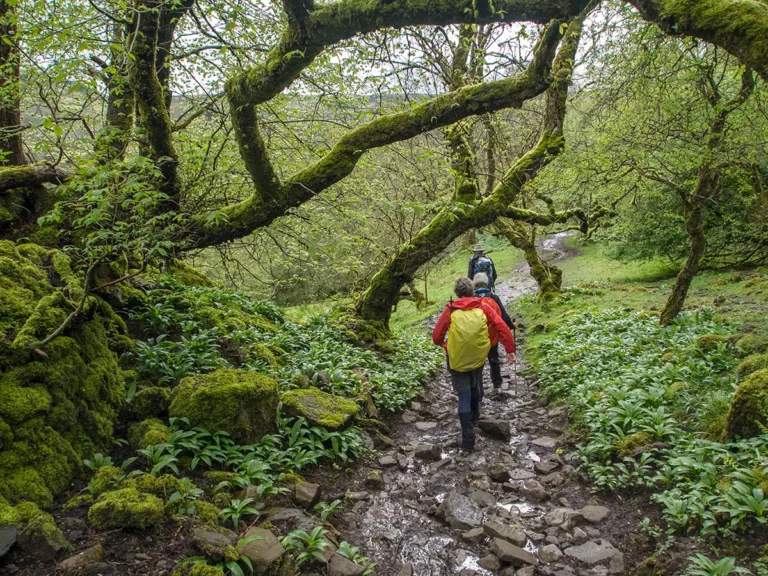Spending time in Montana convinced me that cowboys can tackle everything in their boots. In contrast, this California boy could hike in flip-flops, but the risk will far outweigh the reward.
So, are cowboy boots good for hiking? No. The smooth leather sole of a cowboy boot was designed for slipping in and out of stirrups, making you vulnerable to dangerous slips and falls on dirt and rocky terrain.
But cowboy boots for hiking aren’t all bad. The rugged durability of the leather construction, and stitching that strengthens the shaft of a boot, will protect your feet and ankles during hikes. With hybrid models that offer rubber soles, you could safely hike an easy trail.
This article explains the differences between cowboy and hiking boots to help you better assess the risk of hiking in cowboy boots. And, If cowboy boots are what you’re most comfortable in, we found three top-rated alternatives that can improve hiking safety.
Cowboy boots for hiking: Breaking down the anatomy of a boot.
When shopping for hiking boots, you search for comfort, stability, and durability. As you dial in on the right pair, you continue to narrow options by type of waterproofing, height, and material.
One design feature you never have to ask about is grip. At its core, a hiking boot without a solid grip is just another shoe.
On hikes, the ability to press off any surface safely with complete confidence in the grip of your sole is vital. And hiking boots are how to achieve that.
Hiking boots vs. Cowboy boots for hiking
The anatomy of a cowboy boot does have advantages for hiking. The raised heel helps to dig into mountainsides on descents. In fact, a raised heel is standard in mountaineering boots — the kind you would buy to climb Mount Everest.
The stiff, high leather shaft also protects from rolled ankles, thorny bushes, and snake bites, similar to hunting boots.
But the benefits mainly stop there.
In a survey by the International Journal of Environmental Research and Public Health, 13% of serious injuries when hiking are head injuries caused by slipping and falling. And cowboy boots lack the grip to protect you against a painful fall on a hard rocky surface.
Comparing the soles of hiking and cowboy boots
The sole of a shoe is your connection to the ground. It determines your stability, how quickly you can move up or down a hill, and how safely.

Even on easy flat trails, having grippy rubber propels you forward without slipping, saving your legs and ankles from stress and overworking. With each step, the outsole of shoes and boots take a beating from thousands of small pointy rocks.
On more demanding trails, stepping across boulders while ascending and descending hills requires a shoe that can keep your foot in place and prevent slipping at the wrong moment.
No matter how sure-footed you are in cowboy boots, the terrain of most hikes will lead you to make risky maneuvers.
A firm grip is your best friend on hikes.
Outer shoe construction
The outer construction of a boot determines its flexibility, durability, and breathability. Although leather construction in hiking boots is a popular option — leather is excellent for wet climates — suede leather and mesh are the most common materials.
These materials combine to allow your feet to comfortably breathe with the protective strength of leather. The same leather strength that make cowboy boots so perfect for the outdoors.


Cowboy boot’s tall leather shaft protects against snake bites and thick thorny bushes while keeping small rocks out of your shoe. A tight-fitting cowboy boot allows the ankle to mobility without the risk of a rolled ankle when misstepping.
But the laceless design of cowboy boots can cause foot slippage. The toes are slammed, crunched, and folded when feet slip around in a shoe. Toe numbness, blisters, and painful bruising under the toenail soon follow.
Best hiking cowboy boots (Western work boots)
Please note: HikingBeginner.com does not make money from these links and has not tested the boots featured. All boots were chosen for informational purposes.
In today’s age, it seems like we have endless options for everything, and hiking footwear is no different. There are specialized Converse, Crocs, and even western-style hiking boots.
Western work boots are your best alternative to cowboy boots for hiking. However, a boot that ties will better protect your feet and ankles.
Here’s an example of three top-rated “cowboy-style hiking boots”:
Men’s Wolverine I-90 EPX® CARBONMAX® Wellington Boot
Rated 4.4 out of 5 with 85 reviews.

Rocky Ride Insulated Waterproof Wellington Work Boots.
Rated 4.2 out of 5 with 74 reviews.

Carhartt Women’s CWP1250 Work Boot
Rated 4 out of 5 with 296 reviews

Final thoughts
Regardless if it’s a challenging mountainous hike with 1,000-foot elevation changes or an easy well-maintained flat trail, you should think twice about hiking in cowboy boots.
A grippy connection to the ground is crucial to your safety on hikes, and most cowboy boots have as much grip as a pair of dress shoes.
If you’re in a pinch and need to choose a pair of shoes for the trail, consider hiking in cross trainers. They lack ankle stability but have a better grip for easy terrain.
When taking up hiking as a hobby, ditch the cowboy boots and blue jeans.
An investment in a nice pair of hiking boots is essential. Wearing the wrong shoes can turn a beautiful walk in the woods into a dangerous or even deadly situation.
Did you change your mind about wearing cowboy boots for hiking? Share this article to help others. You may save them from a painful injury.








